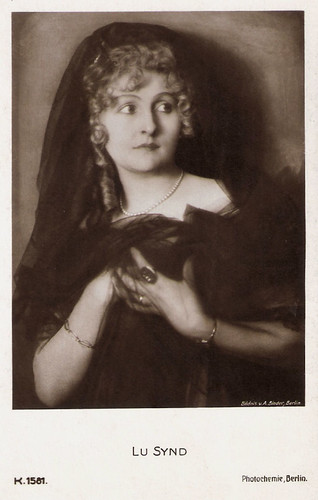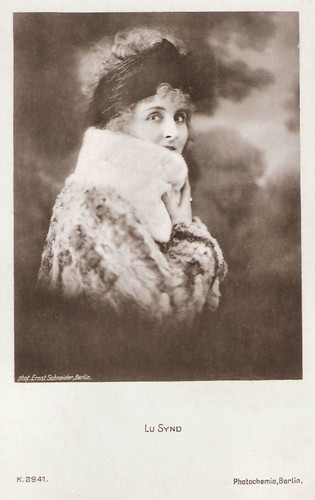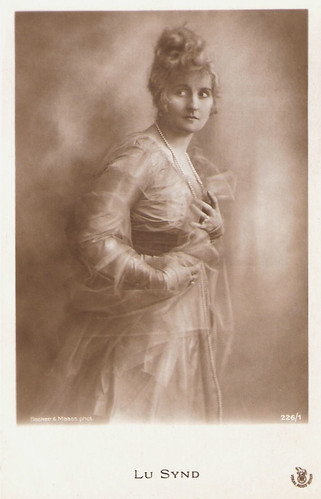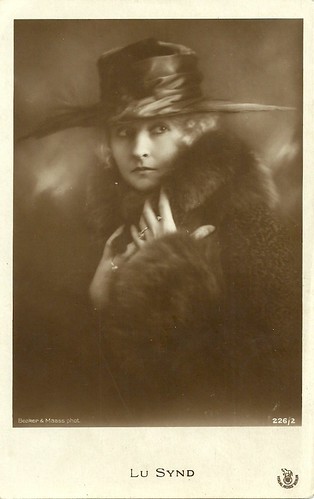German actress Lu Synd (1886-1978) appeared in numerous German silent films between 1916 and 1919. She also produced several films in which she starred.

German postcard by Photochemie, Berlin, no. K 1529. Photo: Alex Binder.

German postcard by Photochemie, Berlin, no. K. 1605. Photo: Nicola Perscheid, Berlin.
Lu Synd was born as Pauline Müller in Konstanz, Germany, in 1886. She was the daughter of a factory owner. She trained as a dancer and performed a.o. in London.
In 1914 she moved to Berlin where she was discovered by film director Richard Eichberg. He gave her her first role in Leben um das Leben/Live for Life (Richard Eichberg, 1916), an Eichberg production starring Ellen Richter.
Lu Synd then launched her own production company Synd film, with which she made three films in a row. The first was Nächte des Grauens/A Night of Horror (1916), directed by Arthur Robison. Besides Synd it co-starred Werner Krauss, Emil Jannings, Hans Mierendorff and Lupu Pick, who would all become well-known actors and directors in the 1920s.
Subsequent films by Synd Film were Die Frau mit den zwei Seelen/The Woman with the Two Souls (Heinrich von Korff, 1916) scripted by Robison; and Das nächste Weib/The Next Wife (Arthur Robison, 1916).

German postcard by Photochemie, Berlin, no. K. 1581. Photo: Alex Binder, Berlin.

German postcard by Photochemie, Berlin, no. K. 2941. Photo: Ernst Schneider.
To Lu Synd's well-known films of the 1910s belong Unsichtbare Hände/Invisible Hands (William Kahn, 1917), the Joe Deebs detective film Europa postlagernd/Poste Restante Europe (E.A. Dupont, 1918) starring Max Landa, Ferdinand Lassalle (Rudolf Meinert, 1918) and Verlorene Töchter/Lost Daughters (William Kahn, 1918).
Other titles were BZ-Maxe & Co. (Otto Rippert, 1916), Die vertauschte Braut/The Changed Bride (1916), Das Spiel vom Tode/The Play with Death (Alwin Neuss, 1917) with Käthe Haack, Der Weg der Erlösung/The Road to Salvation (Joseph Stein, 1918) starring Carl de Vogt, and Die Abenteuer des Kapitän Hansen/The Adventures of Captain Hansen (Harry Piel, 1918).
Rudolf Meinert cast her in his biopic Ferdinand Lassalle, des Volkstribunen Glück und Ende/Ferdinand Lassalle, the tribunes of the people (1918) with Erich Kaiser-Titz as Ferdinand Lassalle, leader of the workers' movement.
In 1919 Aruth Wartan and Lu Synd founded a new film company which produced films in which they starred together: Sündenlust/Desire for Sin (1919), directed by Joseph Delmont and Uwe Jens Krafft; and three films by Delmont: Die Rache des Bastards/The Bastard’s Revenge (1919), Margot de Plaisance (1919) and Der Bastard/The Bastard (1919). Until 1919 Synd was also married to Wartan.
Lu Synd’s last films were Friedrich Feher’s Die letzte Stunde/The Last Hour (1920), and Rennbahnschieber/The Horse Track Slide (Uwe Jens Krafft, 1921), starring Synd and Wartan together again. Between 1919 and 1921 Synd was active in Milan, Italy. She was supposed to act in one Milanese production, La città di vetro/The City of Glass (Eduard Micheroux de Dillon, 1921-1923), but that didn’t happen.
Afterwards Lu’s film career stopped and she concentrated on the stage. She was soon forgotten. Only in the war years she had two bit parts in the films Menschen im Sturm/People in Tempest (Fritz Peter Buch, 1941), staring Gustav Diessl and Olga Tschechowa, and the Marika Rökk film Hab’mich lieb/Love Me (Harald Braun, 1942). Lu Synd died in Berlin in 1978, at the age of 92.

German postcard by Ross-Verlag, Berlin, no. 226/1, 1919-1924. Photo: Becker & Maass.

German postcard by Ross-Verlag, Berlin, no. 226/2, 1919-1924. Photo: Becker & Maass.
Sources: Stephanie d'Heil (steffi-Line - German), Thomas Staedeli (Cyranos), Filmportal.de, Wikipedia (German) and IMDb.
German postcard by Photochemie, Berlin, no. K 1529. Photo: Alex Binder.
German postcard by Photochemie, Berlin, no. K. 1605. Photo: Nicola Perscheid, Berlin.
Her Own Production Company
Lu Synd was born as Pauline Müller in Konstanz, Germany, in 1886. She was the daughter of a factory owner. She trained as a dancer and performed a.o. in London.
In 1914 she moved to Berlin where she was discovered by film director Richard Eichberg. He gave her her first role in Leben um das Leben/Live for Life (Richard Eichberg, 1916), an Eichberg production starring Ellen Richter.
Lu Synd then launched her own production company Synd film, with which she made three films in a row. The first was Nächte des Grauens/A Night of Horror (1916), directed by Arthur Robison. Besides Synd it co-starred Werner Krauss, Emil Jannings, Hans Mierendorff and Lupu Pick, who would all become well-known actors and directors in the 1920s.
Subsequent films by Synd Film were Die Frau mit den zwei Seelen/The Woman with the Two Souls (Heinrich von Korff, 1916) scripted by Robison; and Das nächste Weib/The Next Wife (Arthur Robison, 1916).

German postcard by Photochemie, Berlin, no. K. 1581. Photo: Alex Binder, Berlin.

German postcard by Photochemie, Berlin, no. K. 2941. Photo: Ernst Schneider.
Woman Victorious
To Lu Synd's well-known films of the 1910s belong Unsichtbare Hände/Invisible Hands (William Kahn, 1917), the Joe Deebs detective film Europa postlagernd/Poste Restante Europe (E.A. Dupont, 1918) starring Max Landa, Ferdinand Lassalle (Rudolf Meinert, 1918) and Verlorene Töchter/Lost Daughters (William Kahn, 1918).
Other titles were BZ-Maxe & Co. (Otto Rippert, 1916), Die vertauschte Braut/The Changed Bride (1916), Das Spiel vom Tode/The Play with Death (Alwin Neuss, 1917) with Käthe Haack, Der Weg der Erlösung/The Road to Salvation (Joseph Stein, 1918) starring Carl de Vogt, and Die Abenteuer des Kapitän Hansen/The Adventures of Captain Hansen (Harry Piel, 1918).
Rudolf Meinert cast her in his biopic Ferdinand Lassalle, des Volkstribunen Glück und Ende/Ferdinand Lassalle, the tribunes of the people (1918) with Erich Kaiser-Titz as Ferdinand Lassalle, leader of the workers' movement.
In 1919 Aruth Wartan and Lu Synd founded a new film company which produced films in which they starred together: Sündenlust/Desire for Sin (1919), directed by Joseph Delmont and Uwe Jens Krafft; and three films by Delmont: Die Rache des Bastards/The Bastard’s Revenge (1919), Margot de Plaisance (1919) and Der Bastard/The Bastard (1919). Until 1919 Synd was also married to Wartan.
Lu Synd’s last films were Friedrich Feher’s Die letzte Stunde/The Last Hour (1920), and Rennbahnschieber/The Horse Track Slide (Uwe Jens Krafft, 1921), starring Synd and Wartan together again. Between 1919 and 1921 Synd was active in Milan, Italy. She was supposed to act in one Milanese production, La città di vetro/The City of Glass (Eduard Micheroux de Dillon, 1921-1923), but that didn’t happen.
Afterwards Lu’s film career stopped and she concentrated on the stage. She was soon forgotten. Only in the war years she had two bit parts in the films Menschen im Sturm/People in Tempest (Fritz Peter Buch, 1941), staring Gustav Diessl and Olga Tschechowa, and the Marika Rökk film Hab’mich lieb/Love Me (Harald Braun, 1942). Lu Synd died in Berlin in 1978, at the age of 92.

German postcard by Ross-Verlag, Berlin, no. 226/1, 1919-1924. Photo: Becker & Maass.

German postcard by Ross-Verlag, Berlin, no. 226/2, 1919-1924. Photo: Becker & Maass.
Sources: Stephanie d'Heil (steffi-Line - German), Thomas Staedeli (Cyranos), Filmportal.de, Wikipedia (German) and IMDb.
No comments:
Post a Comment